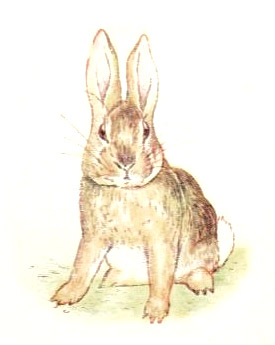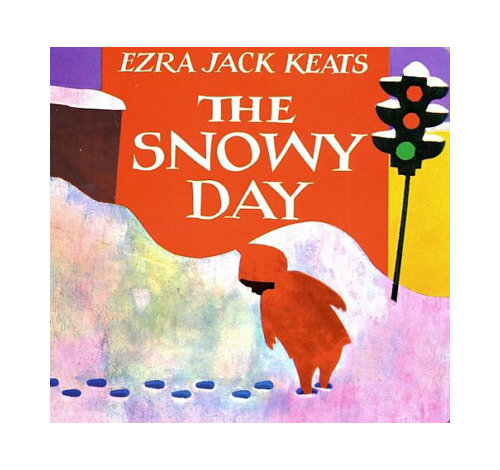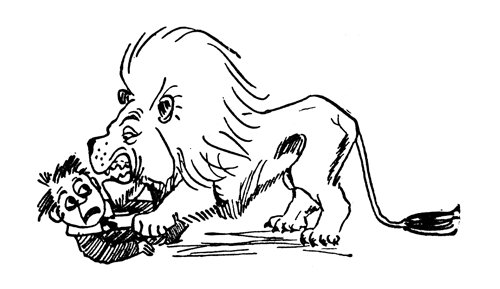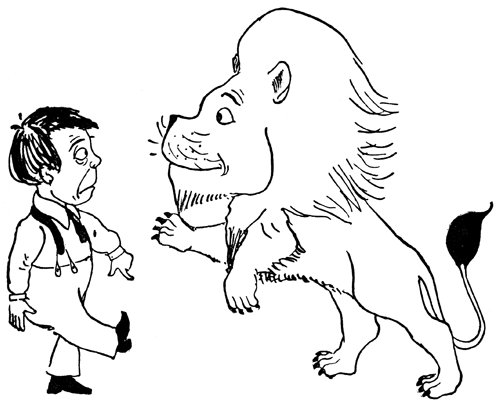What It Means to Be Real
 February 2nd, 2010 by jules
February 2nd, 2010 by jules

He doesn’t say ‘Please.’ He takes it!”
— From Beatrix Potter’s The Story of a Fierce Bad Rabbit, 1906
You can file this post away in the I Was Remiss to Not Tell You About This in ’09 category. But sometimes late is better than never.
In October of last year, Roaring Brook released the great Anita Silvey’s Everything I Need to Know I Learned from a Children’s Book: Life Lessons from Notable People from All Walks of Life. In this book, Silvey shares the results of having posed the following question to well-known Americans in a wide range of fields (authors and illustrators, actors, scientists, reading experts, critics, editors, teachers, athletes, politicians, financiers, and much more): What children’s book left a lasting impact on you — and why? Silvey divides the book into six separate sections, based on common themes in her subjects’ responses (some also taken from statements already in print and interviews): Inspiration, Understanding, Principles & Precepts, Vocation, Motivation, and Storytelling.

It’s a handsome book, a well-designed tribute to the power reading—and, specifically, children’s literature–has to transform lives. Many of the essays are quite moving, and each is accompanied by background material, provided by Silvey, on the highlighted book, as well as an excerpt from the book. You can easily find a copy at the nearest library or bookstore and take it all in; those who love to read books about books won’t be disappointed. I’m not really here to give a review. Those close readers of 7-Imp know I rather burnt myself out on simply providing reviews of new titles; I’d rather give you a peek inside the book or not show up here at all. What I want to share instead today, therefore, are a few of my favorite excerpts.
Not surprisingly to me, those favorites came from the “Storytelling” category. Here are but three bits and pieces from the lengthy book. Enjoy.
Author Ken Follett:  “The Story of a Fierce Bad Rabbit by Beatrix Potter is the shortest thriller ever written. In just 141 words it presents suspense, crime, gunplay, and retributive justice. I read it to my children when there were small, and now I read it to my grandchildren. It still teaches me how to write.”
“The Story of a Fierce Bad Rabbit by Beatrix Potter is the shortest thriller ever written. In just 141 words it presents suspense, crime, gunplay, and retributive justice. I read it to my children when there were small, and now I read it to my grandchildren. It still teaches me how to write.”
Novelist and poet Sherman Alexie: “When I was growing up—a registered member of the Spokane and Coeur d’Alene tribes—The Snowy Day by Ezra Jack Keats was pretty much the only children’s book that featured a protagonist with dark skin. I vividly remember the first day I pulled that book off the shelf. It was the first time I looked at a book and saw a brown, black, beige character—a character who resembled me physically and spiritually, in all his gorgeous loneliness and splendid isolation… The Snowy Day transformed me from someone who read regularly into a true book hound. I really think the age at which you find the book with which you truly identify determines the rest of your reading life…Reading centers on finding yourself in a book…”

Author/illustrator Mordicai Gerstein: “When I was seven—every few weeks after a movie or a lunch out—I went with my parents to the old Pickwick Book Shop on Hollywood Boulevard in Los Angeles. While Mom and Dad browsed for Thomas Mann and the latest Hemingway, I went directly to a shelf where I had discovered a book that fascinated me. I spent my entire time there studying its hilarious pictures, strange rhymed stories, and exotic vocabulary… Finally, after what seemed to me years…I joyfully brought home my very own copy of Hilaire Belloc’s The Bad Child’s Book of Beasts and Cautionary Tales for Children in one volume.

The book was funny…in a sneaky way. It pretended to be a book of deadpan Victorian moral fables but was really something else—a book that made fun of the very thing it appeared to be. It conspired with me, the child, to undermine adult pomposity, rules, and authority. The marvelous drawings by B.T.B. were not afraid to be grotesque… Belloc, and later Lewis Carroll, P.L. Travers, and others introduced me to the deliciously subversive realm of parody and satire. They showed me a way one could respond to the world, and maybe change it, by making fun of it.”

.jpg) What about you? What children’s book impacted your life — and why? What I Learned from what I recall as my first book-obsession is revealed in this post’s title, and it comes from Margery Williams’ The Velveteen Rabbit, published in 1922. I don’t remember being read to and wasn’t read to on a regular basis, according to my mother (though I have one cherished, old photo of my late brother reading to me when we were wee), but someone gave me that book (illustrated by William Nicholson)—I don’t remember who—and I read it so much as a child that I can still recite the first page from memory. I was fascinated by the fairy flower, horrified at how the rabbit was dismissed after the scarlet fever struck, and always rather stunned to see him leaping in joy at the end. The Skin Horse, all grace and wisdom: I wanted him to be my own friend. I also still remember to this day the description of how Nana, always in a hurry, cleaned the nursery and how cruel she seemed. It struck me as a child (though not on a conscious level) how much these few sentences told me about her character, and it’s always stayed with me — so much so that I swear I think of it every time I’m picking up my girls’ toys:
What about you? What children’s book impacted your life — and why? What I Learned from what I recall as my first book-obsession is revealed in this post’s title, and it comes from Margery Williams’ The Velveteen Rabbit, published in 1922. I don’t remember being read to and wasn’t read to on a regular basis, according to my mother (though I have one cherished, old photo of my late brother reading to me when we were wee), but someone gave me that book (illustrated by William Nicholson)—I don’t remember who—and I read it so much as a child that I can still recite the first page from memory. I was fascinated by the fairy flower, horrified at how the rabbit was dismissed after the scarlet fever struck, and always rather stunned to see him leaping in joy at the end. The Skin Horse, all grace and wisdom: I wanted him to be my own friend. I also still remember to this day the description of how Nana, always in a hurry, cleaned the nursery and how cruel she seemed. It struck me as a child (though not on a conscious level) how much these few sentences told me about her character, and it’s always stayed with me — so much so that I swear I think of it every time I’m picking up my girls’ toys:
“There was a person called Nana who ruled the nursery. Sometimes she took no notice of the playthings lying about, and sometimes, for no reason whatever, she went swooping about like a great wind and hustled them away in cupboards. She called this ‘tidying up,’ and the playthings all hated it, especially the tin ones.”
The way she dragged the rabbit out by one ear that first night, in all her haste: “Here…take your old Bunny!” Oh, the horror!
What children’s book changed the way you see the world?

Susan Coolidge’s What Katy Did has her protagonist spend much of the story on her back after a terrible accident in which Katy swings on a swing that is forbidden to her. However, I was fascinated with Katy’s hijinx before she had her accident and that was what I focused upon, plus the fun festivities that happened after Katy decided she would get well. All of the moralizing was lost upon me, I’m afraid. I made Katy into the hero I wanted to be.
The Veleveteen Rabbit is definitely one of my favorites, but for some reason I didn’t come across until I was about 13 and reading it to the 2 year old down the block who was my first babysitting job. Such a beautiful book. I always tear up when reading the passage on becoming real.
The two that I came across earlier on that have stuck with forever are At the Back of the North Wind, by George MacDonald, with this excerpt:
“Do you remember what the song you were singing a week ago says about Bo-Peep — how she lost her sheep, but got twice as many lambs?” asked North Wind, sitting down on the grass, and placing him in her lap as before.
“Oh yes, I do, well enough,” answered Diamond; “but I never just quite liked that rhyme.”
“Why not, child?”
“Because it seems to say one’s as good as another, or two new ones are better than one that’s lost. I’ve been thinking about it a great deal, and it seems to me that although any one sixpence is as good as any other sixpence, not twenty lambs would do instead of one sheep whose face you knew. Somehow, when once you’ve looked into anybody’s eyes, right deep down into them, I mean, nobody will do for that one any more.
Nobody, ever so beautiful or so good, will make up for that one going out of sight.”
And then Antoine St. Exupery’s The Little Prince for “You remain responsible…Forever…For what you have tamed.” and “It is only with the heart that one can see rightly. What is essential is invisible to the eye.”
The two books I kept borrowing from the Newport News Public Library when I was about 4 or 5 were THE PLEASANT PIRATE and FERDINAND. I think I became a lifelong pacifist from that time on, but with a lifelong passion for pirates as well.
Jane
I checked out Nancy Drew books 6 at a time from our local library (the limit). Of all things, it always struck me that Nancy and her dad went to church on Sunday and then they continued on with their crime solving work. I grew up in a family that went to church every Sunday and was encouraged to think that even Nancy knew it was a good idea!
Anastasia Krupnik is the reason I live in Massachusetts. And THE WESTING GAME made me want to be a writer — though after trying my hand at it a couple times, I realized my particular gifts lay elsewhere (read: my stories suh-suh-suh-sucked).
When I was 4 or 5 a babysitter left a copy of The Five Little Peppers and How they Grew at our house, and then moved away without ever getting it. It never became my favorite book-but it opened the door to chapter books for me and-Little House, All-of-a-Kind Family, B Is for Betsy-and I was hooked from then on out.
There are MANY. But off the top of my head:
Any of those books in the forest animals series by Thornton W. Burgess. I must’ve read around 40 of those.
From the Mixed-Up Files of Mrs. Basil E. Frankweiler (E.L. Konigsberg). God, I wanted to run away and live in a museum!
The House of Dies Drear (Virginia Hamilton).
The Grey King (Susan Cooper).
Now I want to re-read them!
So many books as a kiddo formed how I looked at the world…
The one that immediately comes to mind, however, is “Oh The Thinks You Can Think!” by Dr. Seuss. I doubt my parents were aware just how much it would form me into who I am today. The book instilled in me the importance of asking tough quesitons, imagination, and knowing that no one can limit your thoughts. I still quote parts of it by heart. No wonder I ended up getting a minor in Philosophy in college…
I’ve been lurking around 7-Imp for a couple of weeks now and finally got the guts to comment! Even though I haven’t been reading it very long, your blog is a great inspiration to me. I’ll be hanging around and commenting more, I assure you!
Probably a weird choice, but Horton Hatches the Egg. “I meant what I said, and I said what I meant. An elephant’s faithful 100%” was a big deal for me.
Alice in Wonderland; Charlotte’s Web – too many to mention really.
so the first book that popped into my head was “charlie and the chocolate factory” but it is connected to “island of the blue dolphins” and “harriet the spy” because they were all recent books when i was in 4th grade and read aloud in class, in that order. it could have been miss white’s storytelling voice or her impeccable taste, but i think those stories laid the groundwork for all my storytelling notions.
Weirdly enough, all those Good Moral Tales I was read as a child didn’t endear me to reading or the idea of storytelling myself. It was the I CAN Read books that did it — and Seuss’ dreadful and disobedient Marvin K. Mooney who incited my narrative imagination to tell stories about children being bossed and the myriad ways to do what one is told. Imagining the dreadful being attached to the FINGER that shook in Marvin K. Mooney’s face and said to “Please Go Now!” was also fun.
Also, I imagined The Finger sending him to places other than bed. Places like… um… hell.
I was indeed a grimly bloodthirsty little child.
I must say that I agree with all these! I’ll have to add THE LITTLE HOUSE and MIKE MULLIGAN to the mix. Well, and if I am allowed a few more, THE GIVING TREE and 100 DRESSES. All these books have stories that are so moral, but you just don’t realize it at the time. Books about patience, getting older, love, sacrifice and hard work. But to my childhood mind: I just really loved the happy endings and the illustrations, and realize now how much they shaped my perspective of the world.
I remember our reader in grade school had a story at the back of the book (and I peeked ahead and just had to read it) about a poor girl who had a magic dress. Her mother made it, and when she went walking, gold coins stuck all over her dress. Something like that. Can’t remember it all… but I guess it was my first glimpse at a “fairy tale”, besides the usual nursery rhymes you hear as a kid.
I LOVED that story. Maybe because I grew up not having much… it made me feel as if magic and fantasy could happen. And when I was older, the “Trixie Beldon” mystery books I borrowed from a friend. My parents didn’t buy me books or encourage reading that much, except for Bible stories.
“They showed me a way one could respond to the world, and maybe change it, by making fun of it.”
Isn’t that brilliant? It is.
I started reading so young that I do not remember not knowing how to read, and I always read quite a bit, but I’d say it was reading The Hobbit for the first time when I was in the fifth grade that was a real game-changer for me. It was the first thing I read that told me in terms I really understood that no matter what happens to you and is out of your control, life is about the choices you make. This notion gave me great hope, and I really needed some hope when I was in the fifth grade. It made me look at the power stories can have in a whole new way–I certainly started taking them a LOT more seriously.
I would have to say The Secret Garden. I wasn’t read to much as a child either, and came to know such classics as Velveteen Rabbit and Beatrix Potter as an adult. The SG was a book I chose myself from the library, so it feels like a personal discovery. It gave me the feeling that change is possible, magical places do exist, not to mention the excitement of having a place of one’s own where adults couldn’t find you. Also, when a lonely child like Mary Lennox found friends — that really resonated with me. I was left too much to my own devices during my childhood.
The book that changed how I viewed the world was Dr. Seuss’s “There’s a Wocket in my Pocket.” I loved how commonplace the surreal creatures seemed in the boy’s life and home. It opened up a whole new world of creativity and imagination for me. I must admit that for a time I was truly scared of the “vug under the rug” but I couldn’t stop myself from reading the book multiple times a day, even if I did quickly pass over the “vug” pages.
“Charlotte’s Web” was the book that turned me into a reader.
I grew up across the street from a farm, (no pigs, alas) and the annual country fair was right up there with Christmas and my birthday in terms of anticipation. Needless to say, I slipped into Fern’s world quite easily.
Thanks, you all! I love reading these, and I hope others enjoy reading them, too.
This is such a fun post! How nice to peek in on others’ early literary memories.
One of the first books I remember choosing for myself and loving is “Chicka Chicka Boom Boom,” which is still one of the jauntiest books to read aloud. I was also delighted by the unabashed weirdness of Roald Dahl’s stories (especially “The BFG”).
I’m going to speak from the perspective of a teacher. I connected to my students and built a close relationship with them through the reading aloud and discussion of children’s literature. One of our favorite “bonding” books was “Charlotte’s Web.” I love the themes of friendship, cycle of life, and self-sacrifice that are woven into the story–love the way White used language. Every year, my students and I held back tears when I read about Charlotte’s passing away near the end of the book.
My students LOVED when I read them the Ramona books by Beverly Cleary. How we all laughed together at the things Ramona Geraldine Quimby did. Cleary certainly knew what she was doing when she created that literary character. My young students related to Ramona. She was a REAL kid. They understood her thoughts and feelings and behaviors. My boys liked her just as much as my girls.
I think teaching would not have been as rewarding a life experience for me if it had not been for all the wonderful children’s books I read to my students over the years.